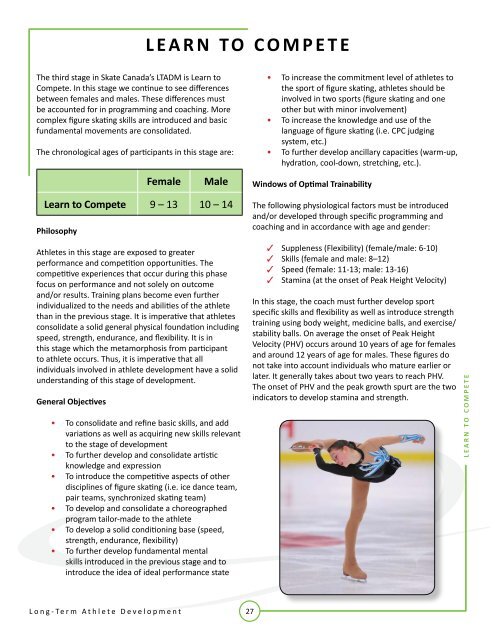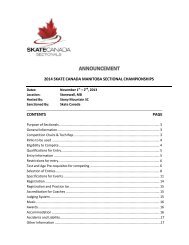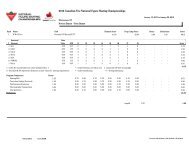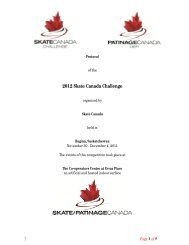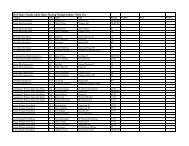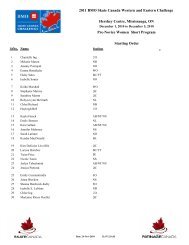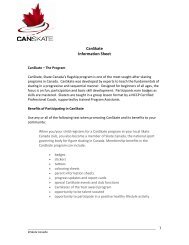LONG-TERM ATHLETE DEVELOPMENT - Skate Canada
LONG-TERM ATHLETE DEVELOPMENT - Skate Canada
LONG-TERM ATHLETE DEVELOPMENT - Skate Canada
You also want an ePaper? Increase the reach of your titles
YUMPU automatically turns print PDFs into web optimized ePapers that Google loves.
The third stage in <strong>Skate</strong> <strong>Canada</strong>’s LTADM is Learn to<br />
Compete. In this stage we continue to see differences<br />
between females and males. These differences must<br />
be accounted for in programming and coaching. More<br />
complex figure skating skills are introduced and basic<br />
fundamental movements are consolidated.<br />
The chronological ages of participants in this stage are:<br />
L o n g - Te r m A t h l e t e D e v e l o p m e n t<br />
865 Sheord Road, Ottawa, Ontario K1J 1H9<br />
Phone 613.747.1007 I Toll Free 1.888.747.2372 I Fax 613.748.5718 I Toll Free Fax 1.877.211.2372<br />
Female Male<br />
Learn to Compete 9 – 13 10 – 14<br />
Philosophy<br />
Athletes in this stage are exposed to greater<br />
performance and competition opportunities. The<br />
competitive experiences that occur during this phase<br />
focus on performance and not solely on outcome<br />
and/or results. Training plans become even further<br />
individualized to the needs and abilities of the athlete<br />
than in the previous stage. It is imperative that athletes<br />
consolidate a solid general physical foundation including<br />
speed, strength, endurance, and flexibility. It is in<br />
this stage which the metamorphosis from participant<br />
to athlete occurs. Thus, it is imperative that all<br />
individuals involved in athlete development have a solid<br />
understanding of this stage of development.<br />
General Objectives<br />
L E A R N TO C O M P E T E<br />
• To consolidate and refine basic skills, and add<br />
variations as well as acquiring new skills relevant<br />
to the stage of development<br />
• To further develop and consolidate artistic<br />
knowledge and expression<br />
• To introduce the competitive aspects of other<br />
disciplines of figure skating (i.e. ice dance team,<br />
pair teams, synchronized skating team)<br />
• To develop and consolidate a choreographed<br />
program tailor-made to the athlete<br />
• To develop a solid conditioning base (speed,<br />
strength, endurance, flexibility)<br />
• To further develop fundamental mental<br />
skills introduced in the previous stage and to<br />
introduce the idea of ideal performance state<br />
27<br />
• To increase the commitment level of athletes to<br />
the sport of figure skating, athletes should be<br />
involved in two sports (figure skating and one<br />
other but with minor involvement)<br />
• To increase the knowledge and use of the<br />
language of figure skating (i.e. CPC judging<br />
system, etc.)<br />
• To further develop ancillary capacities (warm-up,<br />
hydration, cool-down, stretching, etc.).<br />
Windows of Optimal Trainability<br />
The following physiological factors must be introduced<br />
and/or developed through specific programming and<br />
coaching and in accordance with age and gender:<br />
3 Suppleness (Flexibility) (female/male: 6-10)<br />
3 Skills (female and male: 8–12)<br />
3 Speed (female: 11-13; male: 13-16)<br />
3 Stamina (at the onset of Peak Height Velocity)<br />
In this stage, the coach must further develop sport<br />
specific skills and flexibility as well as introduce strength<br />
training using body weight, medicine balls, and exercise/<br />
stability balls. On average the onset of Peak Height<br />
Velocity (PHV) occurs around 10 years of age for females<br />
and around 12 years of age for males. These figures do<br />
not take into account individuals who mature earlier or<br />
later. It generally takes about two years to reach PHV.<br />
The onset of PHV and the peak growth spurt are the two<br />
indicators to develop stamina and strength.<br />
L E A R N T O C O M P E T E


